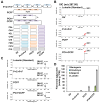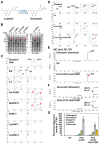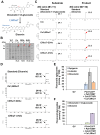Tailored biosynthesis of diosmin through reconstitution of the flavonoid pathway in Nicotiana benthamiana
- PMID: 39494057
- PMCID: PMC11527692
- DOI: 10.3389/fpls.2024.1464877
Tailored biosynthesis of diosmin through reconstitution of the flavonoid pathway in Nicotiana benthamiana
Abstract
The flavonoid diosmin (diosmetin 7-O-rutinoside) is used as a therapeutic agent for disorders of the blood vessels such as hemorrhoids and varicose veins. Diosmin is commercially produced using semi-synthetic methods involving the oxidation of hesperidin, the most abundant flavonoid in citrus fruits. However, this method produces byproducts that are toxic to the environment, and new sustainable methods to produce diosmin are required. Here, we used a synthetic biology approach to produce diosmin without generating toxic byproducts through reconstitution of the diosmin biosynthetic pathway in Nicotiana benthamiana. We first established that N. benthamiana leaves co-infiltrated with all seven genes in the flavonoid biosynthesis pathway produced high levels of luteolin, a precursor of diosmetin. We then compared the activity of modification enzymes such as methyltransferases, glucosyltransferases, and rhamnosyltransferases in Escherichia coli and in planta and selected genes encoding enzymes with the highest activity for producing diosmetin, diosmetin 7-O-glucoside, and diosmin, respectively. Finally, we reconstructed the entire diosmin biosynthetic pathway using three constructs containing ten genes encoding enzymes in this pathway, from phenylalanine ammonia lyase to rhamnosyltransferase. N. benthamiana leaves transiently co-expressing all these genes yielded 37.7 µg diosmin per gram fresh weight. To our knowledge, this is the first report of diosmin production in a heterologous plant system without the supply of a precursor. Successful production of diosmin in N. benthamiana opens new avenues for producing other commercially important flavonoids using similar platforms.
Keywords: Nicotiana benthamiana; diosmetin; diosmin; flavonoid; synthetic biology; transient expression.
Copyright © 2024 Lee, Park, Lee, Song, Kim and Kim.
Conflict of interest statement
The authors declare that the research was conducted in the absence of any commercial or financial relationships that could be construed as a potential conflict of interest.
Figures






Similar articles
-
Genomic insights into the evolution of flavonoid biosynthesis and O-methyltransferase and glucosyltransferase in Chrysanthemum indicum.Cell Rep. 2024 Feb 27;43(2):113725. doi: 10.1016/j.celrep.2024.113725. Epub 2024 Jan 31. Cell Rep. 2024. PMID: 38300800
-
A transient expression tool box for anthocyanin biosynthesis in Nicotiana benthamiana.Plant Biotechnol J. 2024 May;22(5):1238-1250. doi: 10.1111/pbi.14261. Epub 2023 Dec 20. Plant Biotechnol J. 2024. PMID: 38124296 Free PMC article.
-
Rhamnosyltransferases involved in the biosynthesis of flavone rutinosides in Chrysanthemum species.Plant Physiol. 2022 Nov 28;190(4):2122-2136. doi: 10.1093/plphys/kiac371. Plant Physiol. 2022. PMID: 35947689 Free PMC article.
-
Pharmacology of Diosmin, a Citrus Flavone Glycoside: An Updated Review.Eur J Drug Metab Pharmacokinet. 2022 Jan;47(1):1-18. doi: 10.1007/s13318-021-00731-y. Epub 2021 Oct 23. Eur J Drug Metab Pharmacokinet. 2022. PMID: 34687440 Review.
-
[Therapeutic potential of micronized purified flavonoid fraction (MPFF) of diosmin and hesperidin in treatment chronic venous disorder].Vnitr Lek. 2015 Sep;61(9):807-14. Vnitr Lek. 2015. PMID: 26465280 Review. Czech.
Cited by
-
Biochemical evaluation of molecular parts for flavonoid production using plant synthetic biology.Front Plant Sci. 2025 Apr 15;16:1528122. doi: 10.3389/fpls.2025.1528122. eCollection 2025. Front Plant Sci. 2025. PMID: 40303856 Free PMC article. Review.
-
Engineering Nicotiana benthamiana for chrysoeriol production using synthetic biology approaches.Front Plant Sci. 2024 Dec 17;15:1458916. doi: 10.3389/fpls.2024.1458916. eCollection 2024. Front Plant Sci. 2024. PMID: 39741678 Free PMC article.
References
-
- Abdel-Reheim M. A., Messiha B. A. S., Abo-Saif A. A. (2017). Hepatoprotective effect of diosmin on iron-induced liver damage. Int. J. Pharmacol. 13, 529–540. doi: 10.3923/ijp.2017.529.540 - DOI
-
- Ahmed S., Mundhe N., Borgohain M., Chowdhury L., Kwatra M., Bolshette N., et al. . (2016). Diosmin modulates the NF-kB signal transduction pathways and downregulation of various oxidative stress markers in alloxan-induced diabetic nephropathy. Inflammation 39, 1783–1797. doi: 10.1007/s10753-016-0413-4 - DOI - PubMed
LinkOut - more resources
Full Text Sources

